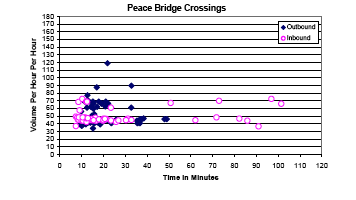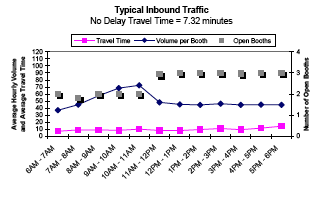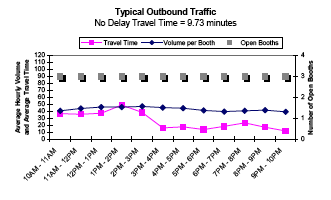Evaluation of Travel Time Methods to Support Mobility Performance Monitoring:
Peace Bridge (Page 3 of 3)
Statistics
Table 22 shows the baseline or "no delay" travel time, the average travel time, and three other measures that indicate the reliability of the travel time estimates. The baseline time (in minutes) is the time needed to travel the study distance (between the starting point in the exporting country and the initial inspection point in the importing country) in free-flow traffic conditions. The average time is computed from all vehicles measured during the data collection period over the study distance. The 95th percentile time is the time (in minutes) within which 95 percent of all trucks can cross the border. The buffer time is the additional time above the average crossing time (in minutes) that it takes for 95 percent of all trucks to cross. The buffer index expresses the buffer time in terms of the average time and is the percentage of extra time that must be budgeted to cross the border within the 95th percentile time. For example, if the average time was 10 minutes and the buffer time was 5 minutes, the buffer index would be 50 percent.
| Baseline Time | Average Crossing Time | 95th Percentile Time | Buffer Time | Buffer Index | |
|---|---|---|---|---|---|
| Outbound | 9.0 | 21.7 | 38.0 | 16.2 | 74.7 |
| Inbound | 8.3 | 21.5 | 83.4 | 61.9 | 265.7 |
From the table, it is apparent that, although the average travel time is similar in both directions, the reliability is significantly more favorable for outbound traffic than for inbound traffic.
Figure 8 illustrates the average travel time experienced for different truck volumes per lane per hour in each direction.

Figure 8. Average Travel Time for Different Hourly Volumes
Figures 9 and 10 show typical average hourly traffic volumes per booth for the study period as well as the measured average hourly travel times. In addition, the average number of open primary Customs booths in each direction is shown.

Figure 9. Typical Inbound Traffic

Figure 10. Typical Outbound Traffic
Conclusions
Lessons learned during data collection activities in this project at this site and at others along the Canadian and Mexican borders with the U.S. have identified several issues that should be taken into consideration to assist future data collection efforts. Some apply to advance planning and the initial site visit and others apply more specifically to the data collection activities themselves.
Planning and Site Visits
- Prior to conducting any data collection project, all jurisdictional and cooperating agencies should be made explicitly aware of the purpose and objectives of the study as well as all the details associated with the data collection project (e.g. dates, times, procedures to be followed during the data collection period, etc.). Failure to do so may result in confusion and possible delay of the study. This has been very time-consuming at some ports and should be adequately accounted for in the schedule. For some agencies, including U.S. Customs, it is important to contact both the federal and local levels. Some entities that should be contacted might not be readily apparent and can include construction companies working on public rights-of-way, state police, city officials, and Thruway Authorities. Some agencies provide verbal approval for the data collection and may even provide supporting documentation to their field staff, yet are reluctant to provide documentation for the data collectors to carry. Every effort should be made to obtain written authorization that can be carried by the data collectors, particularly from bridge authorities and immigration officials. Several times at some sites, the officer at the primary auto inspection booths asked data collectors to go to secondary inspection and speak with immigration officials. Although allowed to continue, this caused some unnecessary delay in the data collection.
- Prior to data collection activities, a general idea of traffic peak periods and conditions should be understood to optimize collection of appropriate traffic data and coverage of the appropriate times. This information should be obtained from discussions with knowledgeable officials and by examining historical traffic data.
- Any additional data needs should be discussed explicitly with the appropriate officials. At some crossings, for example, average hourly truck volumes are not normally recorded and maintained, but can be if special arrangements are made in advance. Alternatively, it may be appropriate to use other means to measure truck volumes, such as roadway counters or having the data collectors indicate the vehicles that pass without their license plates being recorded (assuming continuous data collection during each day). These additional traffic volumes could be used to corroborate data provided by the local authorities or used if their planned data collection did not occur or there was some other problem in providing the data.
- It is also important to be aware of special federal or local holidays on both sides of the border when scheduling data collections as these could affect traffic flows. Some minor holidays that occur on Mondays and Fridays, might not significantly affect traffic for a Tuesday through Thursday data collection period, but may increase the likelihood that key local officials will be on vacation and unavailable should any problems arise.
- When scheduling the data collection times, consider the availability of sunlight or high-powered lighting. It becomes increasingly difficult to read license plates at night as trucks approach with their headlights on (also a problem during rain) and entering the data into the PDAs also becomes more difficult when it is dark.
- Photographs of the border facilities and data collection locations should be taken during the site visits to assist in documenting the collection effort and to better inform the data collectors prior to their arrival on-site.
- Processing, data quality, and analysis of all traffic data require the largest portion of the study time.
Data Collection Activities
- Prior to data collection activities, an explanation and understanding of the procedures to be followed and logistics should be made clear to all members of the study team (e.g., number and location of license plate characters to be recorded, all commercial vehicles should be recorded, when and how to contact the on-site supervisor, etc.).
- Proper identification for all survey members and written documentation of authorization from all jurisdictional agencies should be carried at all times by all members of the study team, especially when conducting business in a foreign country.
- The supervisor should assess all conditions upon arrival for data collection to note any changes from the site visit or prior collection activities. Sometimes unplanned construction or other events may alter the preferred data collector locations or the truck flow patterns.
- While only one supervisor was originally planned for each data collection visit, it was determined that installing one supervisor on each side of the border was highly desired. One supervisor would be designated the overall site supervisor. This presented several benefits, the most important being added safety and security for the data collectors, particularly for a collector who needed to move to a remote location upstream from the border when the queue extended beyond their original location. Other benefits were increased awareness of current conditions and the origin of backups, the increased ability to relieve data collectors for breaks and lunch while maintaining continuous data collection, and assisting with data collection during exceptionally high-volume times or in difficult locations (such as remote spots along a highway when the vehicles were passing at free-flow speeds). Without the extra supervisor, a single supervisor would make repeated trips across the border to check on the collectors, relieve them, and provide them with food and drink if they were not conveniently located nearby. Border delays would often make this an extremely time-consuming process.
- For Mexican data collection, it is recommended that Mexican nationals be used, both as supervisors and as data collectors. This helps to enhance coordination with national, state, and local officials and to minimize the likelihood of immigration or other problems with federal, state, or local agencies.
- As mentioned above, the supervisors should be used to maintain nearly constant data collection during breaks. This improves data quality by ensuring the supervisors repeatedly observe each collector and can identify and correct any problems they might be having. Further, this improves the number of trucks matched at both the #1 and #2 locations, improving the sample size for analysis.
- Communication between the data collectors and their supervisors is crucial to an efficient and successful effort, particularly when one of the data collectors must move upstream past the end of a growing queue. Communication with the supervisor is also important when a data collector is having a problem with an official questioning their authority to do their work or when some other unexpected event occurs. For example, occasionally, there may be an anomaly with the data collection equipment and the collector can receive immediate instructions on how to proceed rather than having to wait until the supervisor next visits their location. Two-way radios (FRS-type with up to a two-mile range) and cell phones work adequately in most situations, but interference and range can limit their effectiveness. Cell phone service can be spotty near border areas. Additional longer-range communication options that do not require FCC approval should be considered for future collections. Obviously, when using cell phones, ensure that long-distance charges and roaming fees will not be significant costs.
- It is important to ensure that the data collectors are safe and comfortable during their long periods of collection. If their data collection locations cannot provide adequate cover from severe rains or heat, additional vehicles should be considered. Comfortable sport chairs with attachable beach umbrellas served to protect the collectors well during light rain and moderate sun. Ensure that the collectors have an adequate supply of water and that facilities are conveniently accessible. This becomes more difficult for the remote locations upstream from the border crossing.
References
Turner, S. M., W. L. Eisele, R. J. Benz, and D. J. Holdener. Travel Time Data Collection Handbook. Report No. FHWA-PL-98-035. Federal Highway Administration, Texas Transportation Institute, March 1998
previous